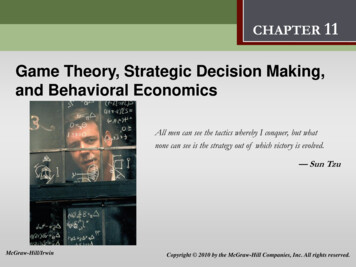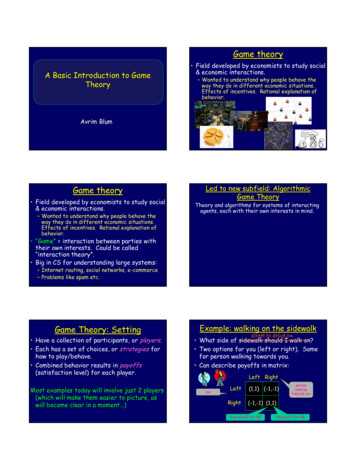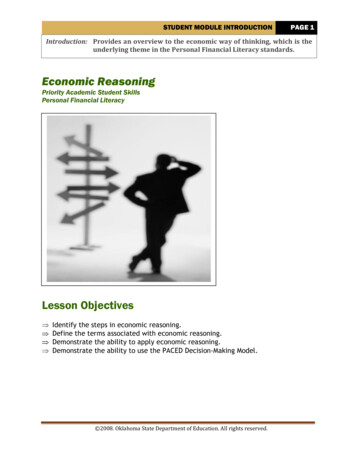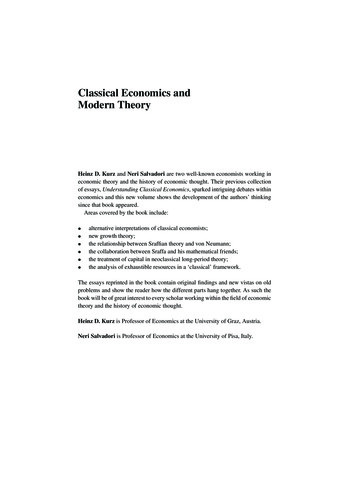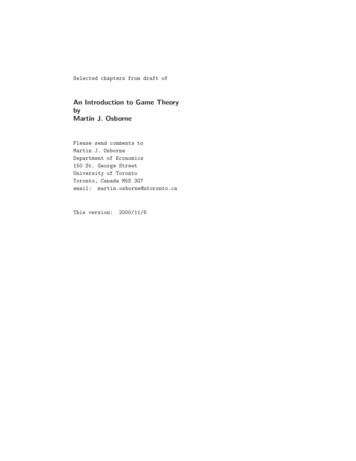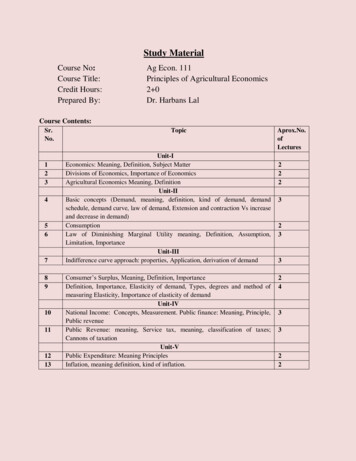
Transcription
Study MaterialCourse No:Course Title:Credit Hours:Prepared By:Ag Econ. 111Principles of Agricultural Economics2 0Dr. Harbans LalCourse cs: Meaning, Definition, Subject MatterDivisions of Economics, Importance of EconomicsAgricultural Economics Meaning, DefinitionUnit-IIBasic concepts (Demand, meaning, definition, kind of demand, demandschedule, demand curve, law of demand, Extension and contraction Vs increaseand decrease in demand)ConsumptionLaw of Diminishing Marginal Utility meaning, Definition, Assumption,Limitation, ImportanceUnit-IIIIndifference curve approach: properties, Application, derivation of demandConsumer’s Surplus, Meaning, Definition, ImportanceDefinition, Importance, Elasticity of demand, Types, degrees and method ofmeasuring Elasticity, Importance of elasticity of demandUnit-IVNational Income: Concepts, Measurement. Public finance: Meaning, Principle,Public revenuePublic Revenue: meaning, Service tax, meaning, classification of taxes;Cannons of taxationUnit-VPublic Expenditure: Meaning PrinciplesInflation, meaning definition, kind of inflation.Aprox.No.ofLectures2223233243322
Unit-ILecture No. 1Economics- Meaning, Definitions and Subject MatterThe Economic problem: Economic theory deals with the law and principles which governthe functioning of an economy and it various parts. An economy exists because of two basicfacts. Firstly human wants for goods and services are unlimited and secondly productiveresources with which to produce goods and services are scarce.In other words, we have the problem of allocating scarce resource so as to achieve the greatestpossible satisfaction of wants. This is the economic problem. It is also called economizingproblem. The economic problem arises from the two basic inter related facts: Man's unlimited desire for the goods in the aggregate, and The limited capital, natural and human resource available to a society for theproduction of goods in aggregate.The content of economic theory: There has been a lot of controversy among economistabout the true content of economic theory or its subject matter. The subject matter ofeconomics or economic theory has been variously defined.According to Adam Smith economics enquires into the nature and causes of the wealth ofnations.According to Ricardo, economist studies," how the produce of the earth is distributed." Thatis, economics deals with the distribution of income and wealth.According to Marshall, economics is a study of mankind in the ordinary business of life and itexamines that part of individual and social action which is connected with material requisitesof well being.According to Pigou, economics studies that part of social welfare which can be broughtdirectly or indirectly into relationship with the measuring rod of money.Professor Lionel Robbins defines economics as a study of the allocation of scarce resourcesamong competing ends or uses.Each definition of economics given above is incomplete and inadequate since they do notindicate the true scope and subject matter of economics. The following are the main questionswhich have been raised by the economists from time to time. It is worth remembering that allthese fundamental questions arise because of the basic problem of scarcity confronting aneconomy. According all of the available productive resources being fully utilized by theeconomy, or are some of them lying unemployed and unutilized? What goods are produced and in what qualities by the productive resources which areemployed? How are the different goods produced that is what production method are employedfor the production of various goods? How is the total output of goods and services distributed among the member of thesociety?
Are the productive resources being used efficiently?Is the economy's productive capacity increasing, declining or remaining staticovertime?The six questions listed above have been the concern of economic theory from time totime. All of them arise from the fundamental problem of scarcity.Meaning and definitions of economicsIn our opinion, it is very essential for a student to have some definitions in mind as a workingbasis. Besides, the discussion leading to a definition is very useful in giving a clearunderstanding of the subject. The following are some of the definitions put forward from timeto time.Early Definitions: Science of WealthIn the 18th century, Adam Smith, The Father of Classical Economics defined economics inhis well known book" Wealth of Nations" as “An Enquiry into the Nature and Causes of theWealth of Nations”. So, according to Adam Smith, economics was concerned with an enquiryin the nature and causes of wealth of nations. Thereby economists called economics, theScience of Wealth.According to French economist J. B. Says, economics is the science which treats of wealth.The American economist F.A. Walker says that economics is that body of knowledge whichrelates to wealth.Prof. Walker defines economic as the body of knowledge which relates to wealth.Thus, in these definitions a key position was assigned to wealth in the study of economics.Adam Smith and his associates treat economics as nothing more than a "Science of Wealth."Thus in these definitions a key position was assigned to wealth in the study of economics.Marshallian Definition: Science of Material Welfare"Economics is a study of mankind in the ordinary business of life; it examines that part ofindividual and social action which is most closely connected with the attainment and with theuse of the material requisites of well being- MarshallThus, Dr Marshall defined economics as the study of man's action in the ordinary business oflife; it enquires how he gets his income and how he uses it. Thus, it is on the one hand a studyof wealth, and on the other hand, which is more important; a part of the study of man.“Economics is the study of the general methods by which men cooperate to meet theirmaterial needs.- BeveridgeAccording to these economists, the aim of economics is to study human activities which areconducive to human welfare in its material aspect.Robbins' Definition: Science of Scarcity or Science of ChoiceProf L. Robbins put forth his definition in 1932 in his famous book." The Nature andSignificance of Economic Science" He defined economics as “The Science which studieshuman behavior as a relationship between ends and scarce mean which have alternative uses.This definition mean:
Our wants are unlimited.Means to satisfy these wants are strictly limited.Hence a man has to make choice.In other words, economics is a study of the allocation of scarce means capable of alternativeuses, among competing ends for the attainment of a maximum result in the achievement ofthese ends.Modern Definition:It is now considered that economics is much more than merely a theory of value or ofresource allocation.The credit for bringing about a revolution in economic thinking goes to the Lord J.M. Keynes.According to him, economics studies how the levels of income and employment in acommunity are determined. Thus, in Keynesian term, economics is defined as the study of theadministration of scarce resources and of the determinants of income and employment.In Benham's words, economics is a study of the factors affecting the size, distribution andstability of a country's national income.Thus, a study of economic growth and of economic stability forms an integral and importantpart of the study of economics. A good and adequate definition of economics must coverthem.Major economic problems:In view of the scarcity of means at our disposal and the multiplicity of ends we seek toachieve, the economic problem lies in making the best possible use of our resources so as toget the maximum satisfaction in the case of consumer and maximum output or profit for aproducer. Economic problem consists in making decision regarding the ends to be pursuedand goods to be produced and the means to be used for achievements of certain ends.From the definition of economic problem we can derive the following fundamentals problemswhich an economy has to tackle.(1) What to produce: The first major decision relates to the quantity and the range ofgoods to be produced since the resources are limited we must choose between differentalternative collections of goods and services that may be produced.It also implies the allocation of resources between the different types of goods e.g.consumer goods and capital goods.(2) How to produce: Having the decided quantity and type of goods to be produced wemust next determine the techniques of production to be used e.g. labour intensive andcapital intensive.(3) For whom to produce: This means how the national product is to be distributed, i.e.who should get how much. This is the problem of the sharing of the national product.(4) Are the resources economically used? : This is the problem of economic efficiency orwelfare maximization. There is to be no waste or misuse of resources since they arelimited.
(5)(6)Problem of full employment: Fullest possible use must be made of the availableresources. In other words, an economy must endeavor to achieve full employment notonly of labour but of all its resources.Problem of growth: Another problem for an economy is to make sure that it keeps onexpanding or developing so that it maintains conditions of stability. It is not to be static.Its productive capacity must continue to increase. If it is an under-developed economy.It must accelerate it process of growth.
Lecture No.2Division of Economics – Microeconomics and Macroeconomics, its SubjectMatter, Scope and ImportanceNature of economics: scope and method:The subject matter or the study of economics has been divided by modern economists intotwo parts: Microeconomics and Macroeconomics. These two terms were first coined and usedby Ragnar Frisch. The term microeconomics is derived from the Greek word mikros, meaning‘small’ and the term macroeconomics are derived from the Greek word makros, meaning‘large’.When we are analyzing the problem of the economy as a whole it is macroeconomic studywhile on analysis of the behaviors of any particular decision- making unit, such as a firm andindustry, a consumer, constitutes micro economics.Micro economics is also called Price Theory and Macro-economics is called Income theory/EconomicsMicro economics(i) Market economy(a)(b)Theory of demand (consumption)Theory of production and cost(a b Theory of product pricing)(ii) Theories of distribution/Factor pricing1. Rent2.Wages3.Interest4.ProfitMacro economicsDifferent policy measures to solve the majoreconomic problemsEconomic problem-poverty, unemployment,,inequalities in income and wealth, inflationand deflation, etc.(iii) Welfare economics orEconomic Polices- Monetary, Fiscal Pascal,Theory of economic welfareIndustrial, trade, etc.When we are analyzing the problems of the economy as a whole it is macroeconomic study.While an analysis of the behaviour of any particular decision- making unit, such as a firm andindustry, a consumer, constitutes micro economics.Micro- economics is also called Price Theory and Macro-economics is called Income theory.Micro-economics: Micro-economic theory studies the economic actions and behaviour ofindividual decision- making units and small group of individual units such as consumers,resource owners and business firms, various industries and markets. We discuss how thevarious cells of the economic organism, that is, the various units of the economy such asthousand of consumers, thousands of workers and resource suppliers in the economy do their
economic activities and reach the equilibrium states. When we speak of micro-economics,what we mean is that it is some small part or component of the whole economy that we areanalyzing.E.g. we may study an individual’s consumer’s behaviour, or that of an individual firm or whathappens in any particular industry. In micro-economics, we study the price of a particularproduct or a particular factor of production and not the general price level in the country.Similarly it is demand of an individual or that of an industry that is studied and not theaggregate demand of the entire community. Likewise, income and employment, etc. arestudied.A noteworthy feature of micro- approach is that, while conducting economic analysis on amicro basis, generally an assumption of full employment in the economy as a whole is made.On that assumption, the economic problem is mainly that of resource allocation or of theoryof price.The four out of six basic questions earlier listed fall within the domain of micro-economicsImportance and uses of micro-economics:Micro- economics occupies a vital place in economics and it has both theoretical andpractical importance. From the theoretical point of view, It explains the functioning of a free enterprise economy. It tells us how millions of consumers and producers in an economy take decisionsabout the allocation of production resources among millions of goods and services. It explains how through market mechanism goods and series produced in thecommunity are distributed. It also explains the determination of relative prices of the various products andproductive resources. It also explains the conditions of efficiency both in consumption and production anddeparture from the optimum.As for practical importance, micro-economics helps in the formulation of economicpolicies that will promote the welfare of the masses. Micro-economic analysis is also usefully applied to the various applied branches ofeconomics such as Public Finance, International Economics.Limitations of micro-economics:Micro- economic analysis suffers from certain limitations.(a) It cannot give an idea of the functioning of the economy as a whole. An industry maybe flourishing, where as the economy as a whole may be languishing.(b) It assumes full employment which is a rare phenomenon at any rate in the capitalistworld.Macro-economics: Macro-economics is concerned with aggregate and averages of the entireeconomy, such as national income, aggregate output, total employment, total consumption,saving and investment, aggregate demand, aggregate supply general land of prices, etc. westudy how these aggregate and averages of the economy as a whole are determined and whatcauses fluctuation in them.
Macroeconomic deals also with how an economy grows. It analyses the chief determinants ofthe economic development and the various stages and processes of economic growth.Utility of macro-economics:The macro-approach is useful in several ways.1. It is helpful in understanding the functioning of a complicated economic system.2. It gives a bird’s eye view of the economic world.3. It is of the utmost significance for the formulation of useful economic policies forthe nation.4. It also occupies an important place in economic theory in its pursuit of thesolution of urgent economic problems.Thus, we are able to study the economy in its dynamic aspect.Limitations of macro-economics:Macro-analysis has limitations of its own. Individual is ignored altogether; it is the individual welfare which is the main aim ofeconomics. It overlooks individual differences. E.g. general price level may be stable, but theprices of food grains may have gone spelling ruin to the poor.Thus, according to the views of the economist today, the subject matter of economicsincludes. Price theory (or micro-economics) Income and employment theory (or macro-economics) and Growth theoryHence, broadly speaking, economics may be described as a study of the economicsystem under which men work and live. It deals with decisions regarding thecommodities to be produced and services to be rendered in the economy, how toproduce them most economically, distribute them properly and to provide for thegrowth of the economy.Scope of economics: Scope mean sphere of study. We have to consider what economicsstudies and what lies beyond it. The scope can be studies through 4 important parts.(a) Subject matter of economics.(b) Whether economics is a social science?(c) Whether economics is a science or an art?(d) If economics is science, whether it is positive science or normative science.(a) Subject matter of economics:Economics has subject matter of its own. Economics studies, only one aspect of man’slife and work. It only tells us how a man utilizes his limited resources for the satisfactionof unlimited wants. He must spend the money and time to derive maximum satisfaction.This is subject matter of economics.Economic activities- It we look around we see that farmers, doctors, traders, teachers, etc.do their work. They are all engaged in what is called an economic activity. We may saythat when man is engaged in economic activity, he is busy in earning money. He needs
money to satisfy his wants. A man wants food, clothes and shelter. To get these things hemust have money. To get money he must work or make an effort. Efforts lead tosatisfaction.Thus wants, effort, satisfaction sum up the subject matter of economics. When one want issatisfied another one crop up or some wants occur after some period of time and againman has to satisfy that want he has to make some effort.Thus, we can say that subject matter of economics is:Consumption– Satisfaction of wantsProduction– Producing the things or creating utility.Exchange– Various markets, forms, buying and selling and how prices aredetermined i.e. money credit, banking, etc.Distribution– sharing of all that is produced or share of profit among all factors i.e.workers, land lords, businessman, capitalist, etc.(b) Is economics a science?Economics is not only a science but also an art. It is a science in its methodology and an art inits application. It has a theoretical aspect and is also an applied science in its practical aspects.Science is a systematized body of Knowledge. A branch of knowledge becomes systematizedwhen facts are collocated and analyzed to find out a relation between cause and effect. It laysdown general principles which help to explain things and guide us. It is to be called science.E.g. Nitrogenous fertilizer increases rice field.Economics is also an art which is also a systematized body of knowledge. An art lays downpercepts or formulae to guide people who wants to achieve a certain aim e.g. removal ofpoverty, increase in rice production. It is also both an art and a science. Thus scope ofeconomics is very wide indeed.It is now agreed that economics is a fully fledged science. In fact, it is in no way less thanother sciences.(c)Economics is a social science:Economic is primarily a study of man and not of wealth but it does not study man who hasrenounced the world. It studies human being but it does not study them as isolated individuals
living in forests or in mountain caves. It studies man living in organized society, who live insociety affecting society from their action and themselves exposed to social influenceseconomics has their to study social behavior, i.e., behavior of men in groups. Exchanging hisgoods for those of others, influencing them by his action and being influenced by them inturn. Thus, he depends on them and they depend on him. Economics thus a social since as it isconcerned with the behavior of an individual living in a group.(d)Positive science or normative science:In discussing the scope of economics, we have also to consider whether economics is apositive or a normative science.Positive science explains why and wherefore of things that means their causes and effect. Anormative science discusses the rightness or wrongness of the thing. Economics is both apositive and a normative science, e.g. per capita income of a country is less and poor personsare becoming poorer and rich persons becoming riches. Whether it is a good sign or bad? If itis bad then what should be done, etc. So economics is positive as well as normative science(what is and what ought to be)A positive science only explains What is and normative science tells us what ought to be, i.e.,right and wring of a thing positive science describes, while normative science evaluates, whenwe say, for instance, that the businessmen, while making decisions, use profit maximizationas the criterion it is positive economics, but, when we ask “ought they use this criterion “, weenter the field of normative economics.We have to consider whether economics can pass moral judgment (normative science) orsimply explain “why” of things (positive science) Economics is, therefore, both a positive anda normative science.
Lecture No. 3 &4Methods of Economics – Deductive, Inductive, Economic Statics andDynamics, Meaning and Types of Equilibrium and EconomyMeaning of equilibrium:The term 'equilibrium' has often to be used in economic analysis. In fact, ModernEconomics is sometimes called equilibrium analysis. Equilibrium means a state ofbalance. When forces acting in opposite directions are exactly equal, the object on whichthey are acting is said to be in a state of equilibrium. Tie a cord to a piece of stone anddangle it in the air. After oscillating from side to side, the stone will come to rest, if nodisturbance is caused. The stone is then in a state of equilibrium.Types of equilibrium:Stable equilibrium: There is stable equilibrium, when the object concerned, after havingdisturbed, tends to resume its original position. Thus, in the case of a stable equilibrium,there is a tendency for the object to revert to the old position.Unstable equilibrium: On the other hand, the equilibrium is unstable when a slightdisturbance evokes further disturbance, so that the original position is never restored. Inthis case, there is a tendency for the object to assume newer and newer positions oncethere is departure from the original position.Neutral equilibrium: It is neutral equilibrium when the disturbing forces neither bring itback to the original position nor do they drive it further away from it. It rests where it hasbeen moved. Thus in the case of a neutral equilibrium, the object assumes once-for-all anew position after the original position is disturbed.Methods of economics:Two methods are generally used in formulating economic generalizations or laws, viz.,Deductive method and the Inductive methodDeductive methodIn the deductive method, we start with a few indisputable facts about human nature orgeneral principles and draw inferences about individual or particular cases. for instance,we assume that self- interest alone governs human behavior and we explain or predictAbout the behavior of a particular individual on this assumption.Merits of deductive method: several advantages are claimed for the Deductive methoda) It is a simple method and helps in explaining complex economic phenomenab) It is certain. If the assumptions are correct, the result must follow.c) It is easy to apply this method. Elaborate Statistical information is not required for itsapplication.d) Since observation and experimentation are not possible where human behavior isconcerned, we have to rely on the deductive method.Limitations:
a) The underlying assumptions may turn out to be untrue thus vitiating the inferencedrawn.b) The deductive method makes Economics dogmatic, because there is a tendency toregard assumptions as always valid.c) This method is dangerous when practical policies are formulated on imperfectassumptions.Inductive method:In the inductive method, we first collect relevant facts and on their basis draw conclusions.That is, we go up from ‘particulars’ to ‘generals’ whereas in the deductive method, we comedown from generals to particulars. In the inductive method, we rely on observation andexperimentation for collecting facts. Hence, this method has a sound basis. But, the danger isthat hurried conclusions may be drawn from insufficient, incorrect or partially correct facts.History provides experiments in the form of measurer adopted. Large numbers ofstatistical publications are brought out in every country. These and other materials facilitatethe application of the inductive method in modern terms.Conclusions: integration of the two methods:We find that both deductive and inductive methods suffer from certain short comings.Hence, the solution lies in the application of both so that one supplements the other. It isremarked that both methods are needed in economic theorizing as right and left foot are bothneeded for walking.Thus, true solution of the contest about method is not to be found in the selection ofdeduction or induction but in the acceptance of deduction and induction”(Wagner).Which of the two methods is to be used in a particular situation depends on the natureof the inquiry, the material in hand and the stage which the inquiry has reached.In short, the true scientific method thus consists of three different stages, viz.,I. Construction of theories.II. The deduction of conclusions or predictions from the theories.III. The testing of theories.Different types of economy:The economy may be classified in a number of ways. A layman, for instance, may classifyeconomies as rich and poor. In a rich economy, the per capita income and the standard ofliving are very high, where as in a poor economy like that of India, the per capita income isextremely low and the average citizen hardly gets two square meals a day.Simple or complex economy:The economies can also be classified as simple or complex. A simple economy like that of anisolated Indian village is a self- sufficient economy. All the needs of all the villagers are fullysatisfied in the village itself. It has no trade with the outside world. The requirements of thepeople must be very few. Each family in the village may be carrying on what is called
subsistence economy, i.e., producing enough of all goods to satisfy its own wants. For a longtime, the Indian farmers carried in subsistence farming, i.e., producing for the family and notfor market.The economy of the modern town or city is an example of a very complex economy. Millionsof people are crowded together in a small area and there are hundreds and thousands ofoccupations. There is extreme degree of specialization of products and businesses, and noperson can even dream of self sufficiency. To be self-sufficient is considered neither desirablenor feasible. for the satisfaction of the want of the people millions of workers producers andbusiness man must co-operate good have to come sometime from the farthest and of the world, just think how many hundreds of people – producers of raw materials for paper industry,paper manufactures , printers and the workers , the authors and the writers of hundreds ofbooks that may have consulted, publishers , representatives long chain of middle men andretail book-seller – must have cooperated to place this book in your hands. Specification andoperations that it necessitates it in the form, of mutual exchange are the dominantcharacteristics of a modern economy.Agricultural and industrial:The economics can further be classified as agricultural and industrial. In an agriculturaleconomy, agriculture in the main occupation of the mass of the people, the economy largelyproduces agricultural products, raw materials and food gains. They export these commoditiesand import manufactured goods. Such economies are generally backwards and poor. On theother hand, industrial economics are rich and advanced. The towns and cities representindustrial economy. A country where the bulk of the population resides in the rural areas is anagricultural economy; where as a country with predominantly urban population is an exampleof an industrial economy.Socialist economy:There is still another classification, socialist economy and capitalist economy, in the socialisteconomy, as that of the U.S.S. R, and China all means of production, firms and factories, etc.,are socialized. That is, they belong to the state. There is no private sector; it is all public sectorenterprises, the instruments of production are owned and managed by the state in the interestof general welfare. All profit goes to the state to be ploughed back in further economicdevelopment or to be spending on the welfare of the people. There may not be absoluteeconomic equality but equality of opportunity is guaranteed. Employment is guaranteed. Theresource are located not according to demand or wishes of the people but by a centralauthority with a view to the overall interest of the State.Capitalist economy:Such an economy prevails in the U.S.A., the U.K., Western Europe and most other countriesof the world. In this economy, economic decisions regarding productions are taken by privateentrepreneurs who are solely guided by the expected rate of profit based on consumer’preferences, actual or anticipated. Thus profit motive is the main sprigs of all economic
activity. The institutions of private property, dominants role of the entrepreneur,uncoordinated nature of the economic activity, competitions as well as cooperation and classconflicts are some of the important features of a capitalist economy.However, the more important classifications are, whether and economy isa) Developed or under- developed, orb) Free – enterprises, unplanned or controlled and planned economy.Under- developed and developed economies:Under- development refers to low level of economic and technical achievement. Thepeople are generally poor and their productivity is low. The Indian Planning Commissionsdefines as under- developed country as one “ which is characterized by co-existence, ingreater or less degree, of unutilized or under- utilized man- power, on the hand and ofunexploited natural recourses on the other.”The main characteristics of under- developed economies are; excessive reliance onagriculture, a rapidly increasing population, capital deficiency, under- utilization of humanand natural resources, low per capita income, low standard of living, uneconomic socialstructure. Under – develop infra
The content of economic theory: There has been a lot of controversy among economist about the true content of economic theory or its subject matter. The subject matter of economics or economic theory has been variously defined. According to Adam Smith economics enqu

